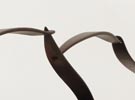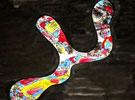Preface of Qu Qianmei’s Album (Rescript)
The first time I met Qu Qianmei was when I paid a visit to her studio, I was secretly surprised at her creation as it deeply stunned me. It is a long time since I have seen such a captivating masterpiece. I had to question how a frail woman like her could endure such a burden. Where did the mighty explosive power come from? How could she bring about such melancholic profound pieces? How could she render such a bitter tone of desolation within a dignified tragic atmosphere? As if having experienced a war or disaster, they represent a deeply worried, traumatic, and catastrophic view of the nirvana of life. I could not help thinking of those “charred landscapes” of Kiefer which are also vast barren depictions of nature that use a gloomy tone. This “sense of scorched earth” is imbued with traces of history and war while retaining the spiritual shadow left by the war of the German post-war generation. In Qu’s work, I feel a kind of trauma and dull pain that arises from the soul, it does not take the usual personal narrative that is full of female grief and its layout is displayed with a noble tragic consciousness, epic momentum and the grave pathos of destiny.
It is true that one cannot really relate to Qu Qianmei’s works which often make men feel humiliated with this feminine artist. Half an hour ago, she was working here dressed in her overalls. It’s rarely found that there is such a huge contrast between an artist and her works. I could not help tracking down their origins. Obviously, without an “inner requirement”, or inspired by some emotion or spirit, or living through the ups and downs of survival, one could not create such profound works. The reason why abstract art has to offer a depiction of the intelligible concrete world can be found in its real goal which is to guide one directly towards an inner spiritual appeal. It is her strong desire for spiritual pursuit that constitutes her driving force and explosive power that resembles a volcano. Therefore, although these works are strictly scrutinized, they are not pure forms of art; in spite of their experimental nature with different media and materials, they never fall into the enjoyment of materials. Qu Qianmei does not perfect her own art from the nominal sense as her works are provided with both the deep emotional characteristics of expressionism and spiritual strength and the ideological connotations that abstract art should possess.
In the West, abstract art develops by offering up representations of the object with a determination to return to art itself. Therefore the purity of the language becomes its’ primary objective. Although it could only exist as a kind of classical academia due to its ontological value this makes no sense in the post-modern context. While in China, the emergence and development of abstract art do not follow the Western linear logic, it has been extended to the contemporary art world and become a branch of Chinese contemporary art which should not be ignored. The reason it is among contemporary art lies not in the ontological sense, but more importantly in its deep internal relations with its creator’s spirit. Qu Qianmei’s works could be taken as her “individual” answers to the psychic calls and by being driven by her strong emotions. It is this kind of spiritual appeal which makes art itself the subject of the artist so the artist endows her art with a contemporary feature.
Another significant feature of this series of Qu Qianmei’s works is that they render a strong “physical sense”: those grave, intricate and obscure appearances of paintings “piled up” heavily with red brick earth and Gaoling. Not only do they take tragic black as their dominant hue, but they are also framed with heavy welded square steel where the borders are no longer “decorations” for the works but actually an extension of the artist’s narration. Together with the appearances of her paintings they produce a visually strong tensile force which originates from both the restored spirit and the sublimated material. Here as with the medium itself, the significance of materials is self-evident. In other words, these substances make no sense and are just “materials” themselves before being taken into Qu Qianmei’s paintings. However they are endowed with irreplaceable and verbal features when they are selected and composed into the artist’s paintings. These substances are materials that have been transformed into a visual language that can be created into art. This situation does not exist in classical art, as Greenberg pointed out long ago, “Realism and Naturalism of art has covered its medium, they are utilizing art to conceal art; Modernism is using art to remind art. The limitations constitute painting medium…are treated as negative factors in old masters and only implicitly or indirectly recognized. In the modernist works, these same limitations are considered as positive factors and publicly acknowledged.” In Qu Qianmei’s works, these “positive factors” are created as a point of focus and enlarged so that these special materials are made to constitute an abstract form with a strong “sense of reality” and “narrative nature” even using direct presentation of a special situation which is exactly what I mentioned as there existing a “sense of scorched earth” and deep sadness of fate”. Therefore the so-called “physical sense” is actually a kind of bitter survival element and spiritual imagery is aroused by these formalized and constructed materials. Therefore, the purely abstract form has returned to represent a real life experience and religious-like spiritual experience.
Compared with her previous works, Qu Qianmei’s recent series of paintings that have been produced in the past two years have demonstrated a qualitative leap. This leap benefits from three aspects: firstly it comes from her long-term artistic accumulation gained while abroad which broadens her cultural perspective especially her deep preference for Tapies which makes her deeply realize the essence of abstract art; secondly her forthright advanced studies at the Central Academy of Fine Arts has equipped her with a comprehension of “implements” and mastery in handling various media with her interpretation of the relations between “Taoism” and “implements”. However these experiences were not enough to evidence the move in her art as being in leaps and bounds, what really opened her creative window was her trip to Tibet. As she says, “There, I found where my pure land of soul coverts.” Her devoted religious feelings “enlightened” her on the “Taoism” level. Either her reverent affections for the mysterious nature of Tibet or her conversion and piety for religious spirits have made her suddenly realize an “epiphany”: “I could not help unleashing my emotions since I’ve already found my direction.” “Accumulation and fascination of many years has turned into creative passion and hard work, and blended into the red clay on the plateau, integrated into images in my dreams, broken in its all fury…” When you face works born in the artist’s intense passion of life, how could we not turn from an inquiry into the works to the creator? It is in this respect that Qu Qianmei’s abstract works are recognized as being closer to the essential characteristics of artistic self-expression.
In the early years of the 1980s, there was still no room for abstract art in China and it was officially regarded as “bourgeois decadent art”. Even in the past 20 years, abstract art remains on the fringe of the art world in China. It is not officially favored nor is it thought of highly in the market. The most pathetic thing about it, is that it is believed to have nothing to do with contemporary art by academics. As there are still many artists interested in it which have been persistent so in recent years it has finally developed into a hot issue. This has been relevant to the involvement of many outstanding abstract artists who have now returned to abstract art such as Su Xiaobai, Jiang Dahai, Zhang Guolong, Tang Chenghua, etc. Now with the “splendid debut” of Qu Qianmei who has been in France for more than 20 years another mainstay is added to the Chinese abstract art scene.
After a short historical review, we find the earlier group of Chinese abstract artists has mainly matured overseas as well as in Hong Kong and Taiwan such as Zhu Yuanzhi, Chen Yinpi, Zhao Chunxiang, Zeng Youhe and Wei Letang who have settled in the U.S.A ; Zhao Wuji and Zhu Dequn who are in France; Xiao Qin is in Italy. If coupled with artists who went overseas from Taiwan and Hong Kong, we actually have a larger number of abstract artists on the list who push their boundaries overseas. It is this “overseas legion” within abstract art that constitutes the “chapter outside” in the history of modern art in China. Although living overseas and adopting western tools and materials in creating art, these Chinese abstract artists maintain their strong blood contact with Chinese traditions in their artistic creations. Today, a new generation of abstract artists has grown up and they will invent a new history and step forward on the basis of former achievements. Qu Qianmei’s art has made us confident enough to face this future.
Completed on the Double Ninth Festival, October 2010 in Wuhan
Rewritten at the end of March 2011 at Huai Yard in the North of Beijing










